Finding Missing Sides of a L Shape
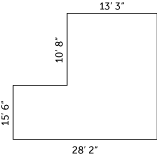
One of the missing sides is a horizontal side (left-right), the other a vertical side (up-down). Also notice that two of the sides, the ones that touch in the bottom right corner, are bigger than the other four sides. Knowing these two things allows us to apply a couple of rules when solving a missing side problem:
- To find out an unknown left/right (horizontal) side, you can only use other left/right sides.
- To find out an unknown up/down (vertical) side, you can only use other up/down sides.
- If you’re finding the big side, ADD the small sides.
- If you’re finding a small side, SUBTRACT the small side from the big side.



Let’s apply the rules to the L shape

- To find the missing horizontal side, SUBTRACT (B → s) 13’3“ from 28’2“.
- To find the missing vertical side, ADD (s → B) 15’6“ and 10’8“.
- Add all six sides together to calculate the perimeter.
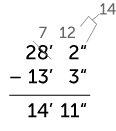

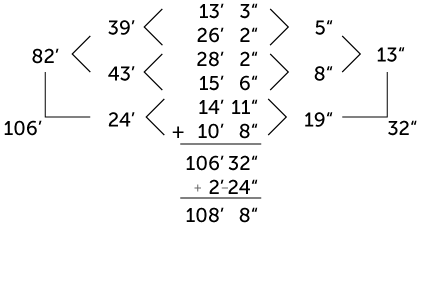
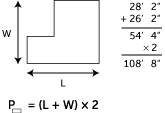
TRICK: L shapes can apply the rectangle perimeter formula: add the two big sides, and double the sum.
It doesn’t matter which side is the length or width, mathematically speaking. The convention is the Length is the Longer side.
We’ll look at two more shapes in class, a C shape and a T shape, so I won’t sketch out each detail here for them.
Finding the Missing Sides of a C shape
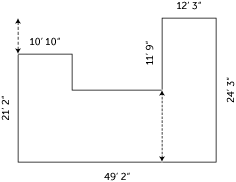
C Shapes are the most difficult of the missing sides problems, because you need to find an intermediate length in order to find the missing side. There are two paths to find an intermediate side to a C shape: the interior and envelope methods.
To find the missing horizontal side, either ADD 10’10“ and 12’3“ and then SUBTRACT the sum from 49’2“, or SUBTRACT both 10’10“ and 12’3“ from 49’2“.
To find the missing vertical side, either SUBTRACT 11’9“ from 24’3“, and take that difference away from 21’2“, (interior method) or, SUBTRACT 21’2“ from 24’3“, and take that difference away from 11’9“ (envelope method).
TRICK: There is no trick for a C Shape.
Finding the Missing Sides of a T shape
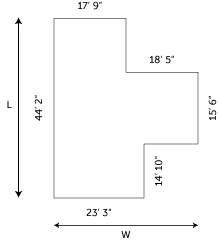
- To find the missing vertical side, either ADD 15’6“ and 14’10“ and SUBTRACT the sum from 44’2“, or SUBTRACT both 15’6“ and 14’10“ from from 44’2“.
- To find the missing horizontal side, ADD 17’9“ and 18’5“, and then SUBTRACT 23’3“ from that sum.
TRICK: T shapes can use the rectangle perimeter formula, just like the L shapes. To find the missing big side, add the two small sides (s → B).



